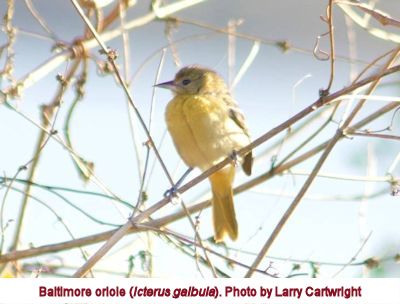In mid-December 2016, FODMers spotted a Baltimore oriole (Icterus galbula) in Dyke Marsh, a rare winter sighting in Northern Virginia. These birds typically migrate to Mexico, Central America and Cuba during the winter months and are likely vagrants here that have either failed to migrate or have stopped short of their final migration destination.
In recent years, people have reported Baltimore orioles more frequently in Northern Virginia in early winter than in previous years. Some biologists speculate that this species has gradually expanded its breeding range northward and birds seen in our area in early winter are the results of “tardy” birds coming down from the north.
The Baltimore oriole is a common breeder in parts of northern Virginia, including Dyke Marsh. The bird has a diversified diet, relying heavily on insects during the breeding season, but it supplements its nutritional needs with fruit, berries and even nectar. As a berry eater, this bird may have a better chance of surviving longer during the winter than a bird that relies almost exclusively on insects, a major problem since insects are dormant in winter in Northern Virginia. Adult females and immature birds of both sexes are much lighter than the adult male Baltimore oriole. The bird in the photo appears to be a young female.


